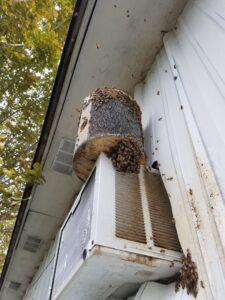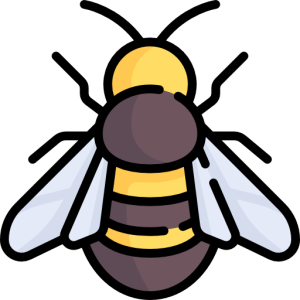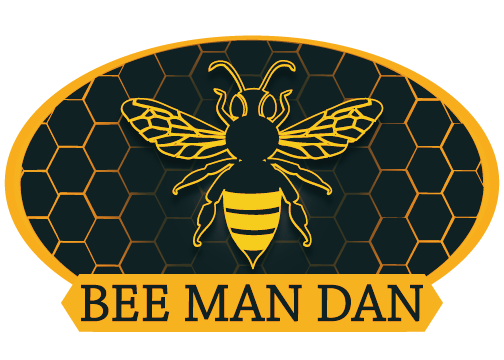If your home’s buzzing with activity that’s not from you or your family, contact Wasp Nest Removal Services for our honey bee removal Katy, TX! No matter what’s made its home within your walls, expert insect enthusiast and beekeeper Bee Man Dan can safely remove it and its hive.
Removing a nest of any kind is a delicate process, especially when that nest is full of protective, flying insects. Even worse, some honey bee nests end up in hard-to-reach spots, such as ceilings, attics, or inside your walls. Trying to get the nest out on your own is too risky – not only do you risk getting stung, but you may not be able to remove the entire nest, meaning that more bees will move into the same spot in no time.
In this situation, it’s best to leave this kind of work to a truly dedicated professional that can perform the thorough work needed to remove a hive properly. Bee Man Dan is highly experienced in removing bee hives and wasp infestations from homes in the Houston area, so call him today to schedule honey bee removal! You can also learn about the authorized vendors he partners with for even more services.

Honey may be sweet, but bees aren’t always so nice! Call today for honey bee removal Katy, TX.
Learning about the Honey Bee
To combat a threat properly, the first step is to learn exactly who (or what) you’re up against. Honey bees are social insects that typically live in large colonies or hives, which can contain tens of thousands of individuals. They are found on every continent except Antarctica and are important pollinators of many crops and wildflowers.
They primarily feed on nectar and pollen collected from flowers and use it to make honey, which they store in their hive as food for the colony. They also collect pollen, which they use as a source of protein to feed their young.
Because they’re social, honey bees live together in colonies that are organized around a single queen bee. The queen bee is responsible for laying all of the eggs in the colony, while the worker bees are responsible for foraging for food, caring for the young, and maintaining the hive. Interestingly, only female worker bees have stingers, but they make up a majority of a hive’s population.
The lifespan of a honey bee varies depending on its role in the colony. Worker bees typically live for just a few weeks during the summer, while queen bees can live for several years. Male bees, or drones, have the shortest lifespan of any honey bee, usually only a few months.
Honey bees build their nests in a variety of locations, including trees, rock crevices, and man-made structures such as buildings (including homes) and utility poles. They build their nests out of wax that they produce themselves, which they mold into hexagonal cells that serve as homes for the young bees and storage for honey and pollen.

Bees and wasps can make their nests almost anywhere.
Signs You Have a Honey Bee Infestation
You might wonder what makes a colony of bees decide to park themselves in your home. Bees are actually drawn to quite a few things that people have in and around their houses, like honey, pollen, propolis, wax, food scraps, and sometimes dirty water that has been sitting still for a long time.
Got some open-lid trash bins full of food outside your garage? You’ve basically put up a huge neon sign that says “All You Can Eat Buffet Right Here!” Sugary foods are even more enticing, such as half-empty soda cans or pieces of fruit. In fact, bees are way more attracted to sugar water or syrup than they are to honey. It’s similar enough to nectar that it can serve as a reliable food source, so if you’ve got discarded snacks lying around, you’ve rolled out a welcome mat.
The presence of certain substances (particularly sugar) will bring honey bees in through open windows, doors, and cracks in the walls. This increases the risk of them deciding that your house is prime real estate for a hive. If you think you might have a bee issue, here are some signs to look for:
- Bees are flying close to your house, near your doors and windows, or close to the eaves that hang over it.
- Honey bees are most likely to build their homes in rotting wood, such as dead trees or old fences, so be wary of these spots.
- There are visible honeycombs or hives around your property.
- Bees keep getting in and out of your home through cracks or other small openings.
It’s not unusual to see bees hanging out in your yard or in nearby trees during the day, especially if there are flowers or other sources of nectar nearby. However, if you see a lot of bees in one place, it could be a sign of an invasion. In this case, you should call Bee Man Dan for honey bee removal Katy, TX right away.
Why Honey Bee Removal Katy, TX is Better Than Extermination
There are plenty of extermination services for hire that guarantee fast pest removal from your home. However, honey bee removal Katy, TX without killing the bees is generally considered to be a more desirable approach than simply exterminating the bees. Here are a few reasons why:
- Preservation of Honey Bees: Honey bees are important pollinators and play a crucial role in the ecosystem. They help to pollinate crops and plants, which in turn helps to produce food for humans and animals.
- Environmental Safety: Exterminating a honey bee hive can be hazardous to the environment. Many pesticides used in extermination are toxic to other animals and insects (as well as humans and pets) in the area and can harm the ecosystem as a whole. By removing the hive without killing the bees, the environmental impact is reduced.
- Cost-Effective: Removing a honey bee hive can be less expensive than extermination. Exterminating a hive may require multiple treatments while removing the hive can often be accomplished in one visit.
- Human Safety: Honey bees can be dangerous if they feel threatened, and may sting people who come too close to their hive. However, professional beekeepers are trained for safe and effective honey bee removal without putting people at risk.

Let Wasp Nest Removal Services help you with honey bee removal!
Overall, removing a honey bee hive without killing the bees is a more humane and environmentally-friendly approach that can benefit the ecosystem, the economy, and human safety.
For quick and safe honey bee removal Katy, TX services, contact Bee Man Dan at Wasp Nest Removal Services today!
Fun Facts for Katy, TX:
- Katy is part of three different counties: Harris, Fort Bend, and Waller.
- The city’s name comes from the MKT Railroad.
- The Katy area was once known as Cane Island.
